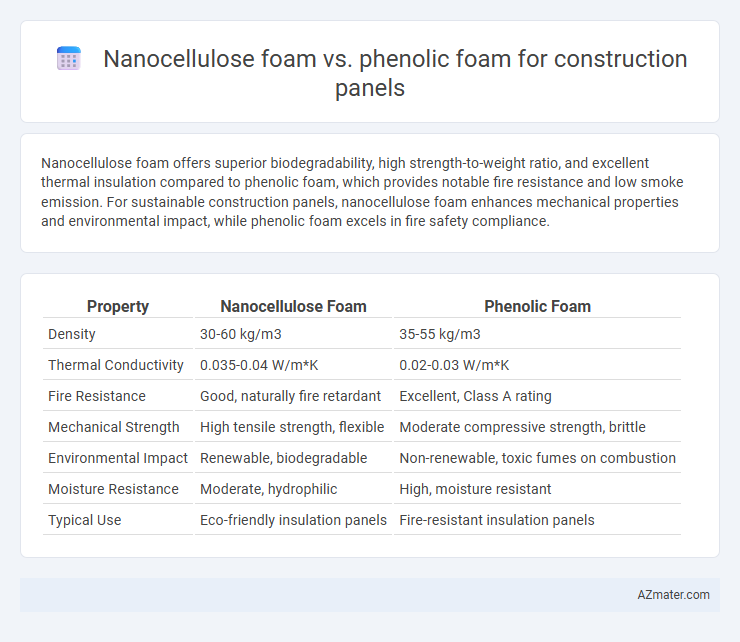Nanocellulose foam offers superior biodegradability, high strength-to-weight ratio, and excellent thermal insulation compared to phenolic foam, which provides notable fire resistance and low smoke emission. For sustainable construction panels, nanocellulose foam enhances mechanical properties and environmental impact, while phenolic foam excels in fire safety compliance.
Table of Comparison
| Property | Nanocellulose Foam | Phenolic Foam |
|---|---|---|
| Density | 30-60 kg/m3 | 35-55 kg/m3 |
| Thermal Conductivity | 0.035-0.04 W/m*K | 0.02-0.03 W/m*K |
| Fire Resistance | Good, naturally fire retardant | Excellent, Class A rating |
| Mechanical Strength | High tensile strength, flexible | Moderate compressive strength, brittle |
| Environmental Impact | Renewable, biodegradable | Non-renewable, toxic fumes on combustion |
| Moisture Resistance | Moderate, hydrophilic | High, moisture resistant |
| Typical Use | Eco-friendly insulation panels | Fire-resistant insulation panels |
Introduction to Construction Panel Insulation Materials
Nanocellulose foam offers superior thermal insulation and environmental sustainability compared to traditional phenolic foam used in construction panels. Phenolic foam is valued for its high fire resistance and low smoke emission, making it a standard choice in building insulation. The rising demand for eco-friendly materials and enhanced mechanical properties positions nanocellulose foam as an innovative alternative in modern construction panel insulation.
Overview of Nanocellulose Foam
Nanocellulose foam, derived from natural cellulose fibers, offers superior biodegradability and lightweight properties compared to traditional phenolic foam used in construction panels. Its high strength-to-weight ratio and excellent thermal insulation make it an innovative alternative for energy-efficient building materials. Nanocellulose foam also provides enhanced fire resistance and reduced environmental impact, aligning with sustainable construction trends.
Overview of Phenolic Foam
Phenolic foam is a rigid, closed-cell insulation material widely used in construction panels due to its excellent fire resistance, low smoke emission, and thermal insulation properties. It offers superior dimensional stability and high compressive strength, making it ideal for structural applications requiring durability and safety. Phenolic foam's low thermal conductivity and resistance to moisture absorption contribute to enhanced energy efficiency and long-term panel performance.
Thermal Insulation Performance Comparison
Nanocellulose foam exhibits superior thermal insulation performance compared to phenolic foam due to its low thermal conductivity, typically around 0.020-0.030 W/m*K, benefiting from its highly porous and nanostructured cellulose network. Phenolic foam, with a thermal conductivity ranging from 0.020 to 0.035 W/m*K, offers good fire resistance but often suffers from brittleness and higher density, which can reduce insulation efficiency in practical applications. The eco-friendly and renewable nature of nanocellulose foam also enhances its appeal for sustainable construction panels while maintaining excellent thermal barrier properties.
Mechanical Strength and Durability Analysis
Nanocellulose foam exhibits superior mechanical strength with high tensile and compressive properties, making it more resilient under structural loads compared to phenolic foam, which tends to be more brittle. In terms of durability, nanocellulose foam demonstrates enhanced resistance to moisture absorption and thermal degradation, resulting in longer service life and stability in varying environmental conditions. Phenolic foam offers good fire resistance but often suffers from reduced mechanical performance over time due to environmental aging and brittleness.
Fire Resistance and Safety Features
Nanocellulose foam offers superior fire resistance due to its natural self-extinguishing properties and low smoke emission compared to phenolic foam, which contains formaldehyde and can release toxic gases during combustion. Its biodegradable and non-toxic nature enhances safety in construction panels, reducing health risks for occupants and workers. Phenolic foam, despite its traditional use in fire-resistant panels, poses environmental and safety concerns due to hazardous emissions and potential carcinogenic compounds.
Environmental Impact and Sustainability
Nanocellulose foam offers superior environmental benefits compared to phenolic foam, as it is derived from renewable biomass and is biodegradable, reducing landfill waste and long-term pollution. Phenolic foam, while effective for insulation, is produced from petrochemicals and involves toxic formaldehyde emissions during manufacturing and disposal, posing environmental and health hazards. The sustainable lifecycle of nanocellulose foam, including lower carbon footprint and recyclability, makes it a preferred eco-friendly alternative for construction panels.
Cost-Effectiveness and Market Availability
Nanocellulose foam offers superior cost-effectiveness in construction panels due to its renewable sourcing and lower production energy compared to phenolic foam, which relies on petrochemical materials with higher manufacturing expenses. Market availability of nanocellulose foam is increasing steadily as sustainable building materials gain demand, whereas phenolic foam remains more widely available but faces stricter environmental regulations impacting supply. Cost and eco-friendly attributes position nanocellulose foam as a competitive alternative in the evolving construction panel market.
Installation and Application Versatility
Nanocellulose foam offers superior installation flexibility due to its lightweight and moldable structure, allowing easy cutting and shaping on-site for custom panel designs. Phenolic foam, while rigid and fire-resistant, is less adaptable during installation, often requiring precise pre-fabrication to fit specific dimensions. Nanocellulose foam's enhanced versatility supports a wider range of applications, including thermal insulation and acoustic damping, compared to the more specialized use case of phenolic foam in fire-rated construction panels.
Future Trends in Construction Panel Materials
Nanocellulose foam offers superior sustainability, high strength-to-weight ratio, and biodegradability compared to phenolic foam, making it a promising candidate for future construction panels. Advances in nanocellulose extraction and foam fabrication are expected to reduce costs and enhance thermal insulation and fire resistance properties. The construction industry is increasingly prioritizing eco-friendly, high-performance materials, positioning nanocellulose foam as a leading alternative to conventional phenolic foam panels.

Infographic: Nanocellulose foam vs Phenolic foam for Construction Panel
 azmater.com
azmater.com